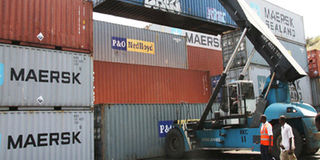VAT debate rages on as transporters doubt data

Businesses persons argue that transporting a 40-foot container from Dar es Salaam to Uganda costs $4,435 while the same costs $2,712 when transported between Kampala and the Mombasa Port.
What you need to know:
Section 2 of the VAT Act stipulates that it is only auxiliary services on transit goods that are subjected to VAT.
Dar es Salaam. The debate on valued added tax (VAT) on auxiliary services is still raging on as transporters now doubt the credibility of data produced by Tanzania Revenue Authority (TRA) on port charges.
While TRA maintains that a drop in the volume of cargo passing through the Dar es Salaam Port is due to global factors, fuelled by a tremble in the China’s economy, businesspersons argue that the high costs of moving containers via Tanzania’s main sea gateway is also blame for the drop. The law in question is the VAT Act 2014 Cap 148 which became effective on July 1.
Section 2 of the VAT Act stipulates that it is only auxiliary services on transit goods that are subjected to VAT.
In a recent statement, TRA said that between April 1, 2015 and April 1, 2016, the volume of cargo being cleared at the of Dar es Salaam Port declined by just 15 per cent as opposed to those being cleared at Kenya’s Mombasa Port which dropped by up to 25 per cent during the same period.
The TRA report showed that the cost of clearing a 40-foot container at the Dar es Salaam Port is $4,123, while the cost of clearing the same size of container at the Mombasa Port is $4,341.
But grouped under their umbrella organisations of Tanzania Association of Transporters (TAT), Tanzania Track Owners Association (Tatoa), Tanzania Freight Forwarders Association (Taffa) and Tanzania Shipping Agents Association (Tasaa), the business unions contend that TRA’s comparative analysis is based on Rwanda which has less port market share than Zambia and the Democratic Republic of Congo (DRC).
In their press statement, the business unions argue that TRA has not done a thorough research to get correct data, stressing that the taxman overlooked several key issues that would help in the making of an informed decision.
In their study, businesses persons argue that transporting a 40-foot container from Dar es Salaam to Uganda costs $4,435 while the same costs $2,712 when transported between Kampala and the Mombasa Port.
“Thus there is a difference of $1,723. This is why Mombasa port is enjoying a bigger market share than Dar es Salaam,” reads a sentence in the transporters’ analysis. Mombasa, they argue, handles 30 per cent of Rwandan cargo.
It also handles 5 million metric tonnes of Ugandan cargo (or 96 per cent of goods destined for Uganda) while Dar es Salaam Port’s 200,000 metric tonnes are equivalent to only four per cent of the cargo destined for Kampala.
Transporters fault TRA for basing its analysis on Rwanda which accounts for only 17 per cent of the total volume of cargo that passes via the Dar es Salaam Port, leaving out Zambia and the DRC which jointly account for 80 per cent of the business of transit goods passing through the Dar es Salaam.
Besides, they say, Mombasa handles 30 per cent of cargo destined for Rwanda despite the fact that to reach the destination, Rwandan traders have to cross two borders when using the Kenya route. Says the statement:
“TRA could also have been interested to know that the Kenyan government has taken a strategic decision of building a dry port at Taveta to shorten the distance between Mombasa and countries served by the central corridor, a strategic measure to compete with the Dar Port.”
the statement reads.
The transporters say that the two giant customers from Zambia have already decided to suspend the use of Dar es Salaam port in transporting their copper on grounds of expensiveness.
“The two copper clients remit Sh269.3 billion compared to Sh39 billion accrued from VAT on ancillary services,” reads the statement in part, arguing that the VAT on ancillary services did not put into consideration the fact that within East Africa, the Dar es Salaam port has a market share of only 27 per cent, far behind 73 per cent of Mombasa.
In its discussions with TRA, the transporters say, it became apparent that the taxman brought the VAT issues without considering the business trends within the region where other competing facilities do not charge the levy. Similarly, they argue, there was no consideration on the other inland infrastructure that has direct impacts on costs of products.
The group argue that they are not objecting to VAT payment but rather, they want the government to look into the technical shortfalls and have the law amended.




